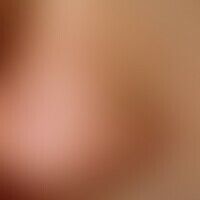Skin transplant, faulty Images
Go to article Skin transplant, faulty
Skin transplantation, defective. fig. 1: Condition after excision of a burn scar with chronic ulceration of the lower leg in a 35-year-old woman. total necrosis of a full-thickness skin graft from the groin used to cover the defect. surgical error: too thick and demanding graft with unfavorable perfusion conditions (better: medium-thickness split skin or close flap plastic).

Skin graft, faulty. Fig. 2 a: Basal cell carcinoma above the upper lip.

Skin graft, faulty. Fig. 2 b: Condition after basalioma excision and covering of the defect with supraclivicular full skin. Upper lip red raised on the operation side due to wound shrinkage. Surgical technique error: free skin grafts in the perioral region unsuitable (better: suture flap plastic).

Skin graft, faulty. Fig. 3: Full-thickness skin graft at the bridge of the nose above the skin level after basal cell carcinoma removal. Surgical error: insufficient preparation of the full-thickness skin flap, subcutaneous fatty tissue was left.

Skin transplantation, faulty. Fig. 4: Defect coverage of the forehead-hairline by means of full skin graft from the inner side of the upper arm after nevus excision in a 47-year-old woman. Surgical technique error: Texture and thickness of the upper arm skin in this region are unsuitable (better full skin from pre- and/or retroauricular, suture flap plastic).

Skin graft, defective. Fig. 5: Defect coverage above the nostril by means of retroauricular full skin after excision of a basal cell carcinoma. Surgical errors: wound edge overlapping, not fitted graft, no optimal donor region (better: graft from the preauricular region that fits the defect to about 80% of its size).

Skin graft, defective. Fig. 6: Graft shrinkage after excision of a basal cell carcinoma at the tip of the nose and defect coverage by means of split skin from the inner side of the upper arm. Surgical error: too thin graft from an unsuitable donor region (better: preauricular full-thickness skin graft)

Skin transplantation, faulty. fig. 7: Shrinking of split skin flaps. defect coverage by animal flaps from the thigh after excision of an extensive lay tattoo on the forearm in a 26-year-old woman. a previous laser treatment was not successful. Surgical technique error: oversized and too thin split skin flaps not fitted (better: three-quarter flaps adapted to the defect size, suture flap plastic and/or serial excision).

Skin transplantation, faulty. Fig. 8: Defect coverage of the nose side by full skin from the upper arm after basalioma excision in a 45-year-old man. Surgical errors: unfavourable and also hairy donor site (better: hairless preauricular full skin transplant).

Fig. 9: Patch effect and suture incision scars in retroauricular full-thickness skintransplant after excision of a basal cell carcinoma at the tip of the nose; surgical errors: unfavorable donor site and transplant selected too small and sewn in under tension (better: transplant from the preauricular region corresponding to about 80% of the defect size).

Skin graft, faulty. Fig. 10: Full-thickness skin graft from the abdominal skin used to cover the wound on the sole of the foot after removal of plantar warts in a 47-year-old man. Surgical technique errors: unsuitable donor site and inappropriate method (better: wait for and promote secondary healing, in the case of larger defects and deep wound surfaces full-thickness skin graft from the joint flexion region).

Fig. 11 a: Excisional defect of the nostril left to secondary healing after removal of a basal cell carcinoma in a 50-year-old woman.

Skin transplantation, faulty. Fig. 11 b: Distortion of the nasal wing cranially due to scar tissue shrinkage, resulting in a tilted position of the nose with narrowing of the nasal cavity and obstruction of nasal breathing.